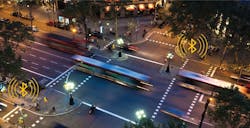A decline in acquiring a driver’s license among young people was identified in Scandinavia in the 1990s.
Since then, this seems to be the trend in all age groups in many developed countries. This is especially the case in urban areas where good public transport coverage and shorter travel distances reduce the need for a private car. At the same time, the ubiquity of always connected mobile devices has not only made information about available transport options easily accessible anytime and anywhere, but also enabled new transport services such as demand-responsive, ride-sharing and peer-to-peer solutions to be provided in real-time.
Add in urbanization, and it is clear that the mobility behavior of people and the transport system itself are going through great changes. Easy-to-use, affordable and accessible public transportation complemented with private transport services for options such as last-mile and off-peak hours trips is the core for efficiently moving masses of people and enabling smart and liveable cities. With increasing numbers of passengers, the more important it becomes to handle the boarding and egress of passengers as smoothly as possible. The public transport infrastructure is very large in terms of area, vehicles and stops where users expect to have specific and relevant information available. While traditional line maps and schedules in paper form satisfy a traveler’s minimum needs, the information is static and cannot be frequently updated. For making relevant real-time information better available, modern and cost-effective solutions for easily accessing contextualized services are necessary.
Beacons shed a light
Bluetooth beacons—the short-range wireless communication devices emitting simple messages in regular intervals to be detected by devices like smart phones—are becoming increasingly common. Small, affordable, bearing a long battery life, and very easy to install nearly anywhere, Bluetooth beacons are finding common use.
Utilizing Bluetooth technology in different ways is more and more common in the context of intelligent transportation systems and services as well. Bluetooth Low Energy (BLE) is one potential technology for supporting (urban) traveller services, including information provision and different ticketing or fare-collection methods. The suitability is associated with its widespread adaptation and low power consumption. The Bluetooth Special Interest Group has projected over 90% of mobile devices globally to be BLE ready by 2018. Users keeping Bluetooth services turned off to save power also is not expected to be a significant hindrance as long as the services are perceived to offer additional value, since it only accounts for about 1-2% battery usage on mobile phones.
There are a variety of ways in which Bluetooth technology is already used in transport and mobility. Bluetooth sensors installed at ends of road sections are used to measure link times and traffic flow by detecting devices in passing vehicles. While less accurate than traditional methods like loop detectors or number plate recognition cameras, it can provide sufficient information for traffic management purposes. The same technology is used at airports to measure and provide estimates on queueing times for security checks. Beacons can provide passengers information such as schedules and line information at a bus stop, or trigger boarding passes or tickets to be brought up at the gate.
Beacons also can be used to augment other positioning technologies (e.g., GPS in urban canyons) and to determine a more exact user location. Based on the location, users can be guided through a subway station and an application can keep track of status of the journey (e.g., at a station, entering the subway or being in the subway) to either confirm progress or to suggest corrective actions.
A combination of precise information and well-designed user interfaces allows a visually impaired passenger, for example, to both receive a confirmation that a bus arriving at a stop is the correct one as well as being provided more accurate directions to the door. Bluetooth, as a communication channel, has been used in smart walkers for the elderly and the mobility challenged along with other sensors to help monitor and report on the user’s location, status and changes in behavior. Similar Internet of Things (IoT) applications also have been incorporated in personal reflectors that could then start blinking in different colors when a child wearing them is approaching a dangerous intersection or leaving a defined geo-fenced area. Solutions like these can improve accessibility and safe, independent mobility of different user groups.
Quick and easy
Simple and quick ticketing is at the heart of keeping public transportation fluid and comfortable. Pre-purchased tickets, travel cards and different electronic solutions like mobile tickets improve passenger flow by reducing the occurrence of slow payment processes by passengers using cash. And, indeed, in different European cities, it is no longer a given that cash is a valid means of payment on buses. While there are different technologies used for ticket validation, such as NFC cards or QR codes on mobile tickets, the practicality and suitability of the options depend on the policy in place. Some countries, cities or regions require the bus driver to confirm the validity of each passenger’s ticket when getting in; others require the ticket to be read both at the beginning and end of the journey (e.g., for distance-based pricing); and some apply an honor-based system where only occasional ticket inspection is used to monitor whether the passengers have a ticket or not.
When it comes to public transport ticketing, payment solutions and Bluetooth, there are ongoing tests (e.g., in Estonia) for using multiple beacons for automatically detecting and tracking when a passenger is in a bus by triangulation without having to take the phone out to validate or activate the ticket. It allows for more advanced usage-based fare systems while the transport authority’s application can collect more accurate statistics and information about travel patterns (e.g., to be used for route planning). With sufficient reliability and accuracy to avoid incorrect detections (such as people driving in a car next to the bus), it is a promising solution for honor-based public transport systems. The technical challenges related to beacon-based ticketing are essentially the same as with Wi-Fi positioning, i.e., the swiftness and reliability of detection (positioning). Of the two, beacons are an interesting opportunity due to lower power consumption and less cost.
Besides quick, easy and reliable ticket validation at one leg of a journey, seamless ticketing across modes and transport operators is an important factor in making travelling without a private car more user-friendly and appealing. For interoperability between different public transport systems, supporting different methods is necessary. PayiQ is a leading example of mobile payment and ticket service solutions that enable simple and secure transactions using different methods and technologies. It offers interfaces for integrating and aggregating different ticket and payment systems as well as reliable ticket validation and fraud prevention. For future solutions that are both cost-effective to implement and user-friendly, PayiQ also is investigating the potential for using Bluetooth as an alternative check-in method in public transport systems where the driver must get a confirmation of a valid ticket with a minimal delay (i.e., right as a passenger steps on a bus).
For investigating the opportunities of utilizing beacons with public transportation, PayiQ is collaborating with VTT Technical Research Centre of Finland, which coordinates a related Living Lab Bus project, in which innovative electric buses by the Finnish company Linkker serve as an open platform for testing new technologies and services in real context in the Helsinki region. Beacon constellations in buses also open avenues for other solutions such as mobile applications that collect user feedback with accurate positioning within the bus included as metadata (e.g., allowing comparison of passenger complaints or answers on noise, temperature, etc., based on where they sit in the bus).
Public-private collaboration that aims to facilitate innovation and implementation of new ideas brings up existing challenges in cost sharing as well as accessibility and reusability of available resources. Rather than different companies investing in and installing their own equipment side by side, openly sharing a resource can enable its wider use and more creativity by lowering entry barriers. Bluetooth beacons are a good example of widely spreading IoT resources that have a lot of potential for enabling the interoperability of services across providers, sectors and regions.
Beacons themselves are simple devices, basically just broadcasting their own existence with a unique identifier. The intelligence comes from applications and back-end systems that know what information should be presented to the user. Therefore, the important thing is understanding the context and environment the beacon is in. Is it, for example, attached to a specific location in terms of coordinates, i.e., near a coffee shop, in a dynamic object such as a bus, or even more specifically, a certain section of the bus or co-located with other sensors?
While there are management tools available from beacon providers, they are typically used by one party for managing a specific set of beacons (e.g., to map the beacons within one store in order to use them for guiding customers). Should the information related to the beacons be openly available and properly documented, third parties would be able to utilize resources already existing in the environment. On a small scale, the digital tag litter can be reduced if, for example, a kiosk and an adjacent bus stop share the same beacon. On a larger scale, the availability of beacons with uniform information at every bus stop enables the same service to be offered to passengers anywhere.
Open Wi-Fi hotspot databases are an example of a global collection of openly detectable device identifiers in the environment that can be used for identifying the context—or at least the general location. The level of detail for the context, however, is very limited. To truly benefit from a repository of beacon information, it needs an extendable data model that should support adding information such as dynamic location, linked resources and beacon groupings for triangulation. Co-shared management of beacons has not yet emerged, but a similar paradigm can be found from the IoT domain where the implementation of services with interoperable Web of Object approach and virtualization of physical devices and resources has already been studied more.
Back-end logic
The possibilities of delivering personalized and contextually relevant services wherever needed are greatly extended as our environment becomes more and more digitally enhanced. Being able to obtain relevant information from our surroundings is a welcome addition to mobility services as they are, by nature, tied to both place (route) and time (schedule). General-purpose resources such as Bluetooth beacons that place the logic in the back-end can be utilized for a variety of information services. The challenge in the near future is to find effective ways of sharing and reusing as well as managing the available resources to support interoperability and scaling of the services.



